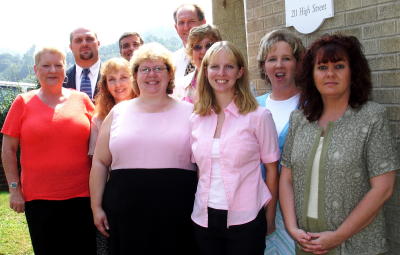
(L-R) front-Susan Anderson Borror, Director of
Continuing Education; Sonnie Strader, Region 4Coordinator; Anna Reno,
Region 2 Coordinator; Amanda Fisher, Administrative Assistant; Tina
Aldridge, Region 2 Community Outreach-Office Assistant; back-Parr
Thacker, Director of Development; Dr. James Malone, Medical Director; Lew
Holloway, Executive Director; Dalena Riggs, Region 1 Coordinator; Kathryn
Greenlief, Region 3 Coordinator. Not pictured: Rhonda Carpenter, Region 3
Community Outreach/Office Assistant; Stacey Murphy, Region 1 Community
Outreach-Office Assistant
The Northern WV Rural Health Education Center celebrated its recent merger and the opening of its new office in Glenville with an Open House on September 14.
Guests included health professionals, hospital administrators, and members of the higher education community, all invested in improving the quality of rural health care. The guests enjoyed a luncheon buffet provided by Aramark Services, Inc. and a brass quintet featuring Glenville State College students.
The Northern WV Rural Health Education Center (NWVRHEC) also has offices in Gassaway, Rock Cave, and Cameron as a result of its July 2005 merge with the WV Rural Health Education Partnerships (WVRHEP) Mountain Health, Little Kanawha Area, and Rural Ohio Valley Consortia.
The organizations merged to establish one entity to manage the rural clinical training of graduate and post graduate health profession students throughout its 23 county service area in Northern WV.
The mission of the NWVRHEC, a community-based organization, is to bring quality healthcare to the underserved populations in 23 West Virginia counties by training, recruiting and retaining health care professionals.
The NWVRHEC serves 23 counties including Barbour, Braxton, Brooke, Calhoun, Doddridge, Gilmer, Hancock, Harrison, Lewis, Marion, Marshall, Monongalia, Ohio, Pleasants, Preston, Randolph, Ritchie, Taylor, Tyler, Upshur, Wetzel, Wirt and Wood.
The major focus of programming for the NWVRHEC includes conducting health professions education with an emphasis on graduate-level students; strengthening rural practice and coordinating patient care through interdisciplinary team building; providing continuing education to reduce professional isolation and improve health care; expanding health professions career paths for underrepresented and disadvantaged high school students; enhancing recruitment and retention efforts at the community level; and developing cooperative relationships to better meet the challenges associated with recruitment and retention efforts.
|



